|
Text and Photos ©2015 by
J. Pint
Related
articles:
Photo
Gallery
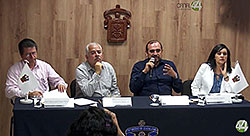
University
of Guadalajara (UDG) geographers
outline the outstanding geological features of Bosque La Primavera at
a press conference proposing the forest as a candidate for membership
in Unesco's Global Geoparks Network.
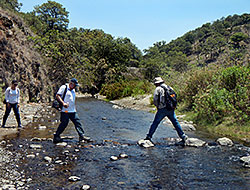
Geographers
Lucia González, Luis Valdivia and Hildelgardo Gómez gingerly crossing
Río Caliente to investigate one of the river's numerous boiling hot
sources.
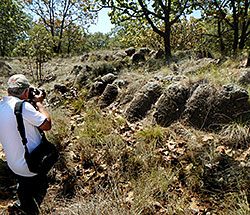
UDG researcher Luis Valdivia photographs fossil fumaroles in
a remote corner of the Primavera
Forest. These are the tips of long cylinders formed ages ago by gas
bubbles rising through volcanic ash.
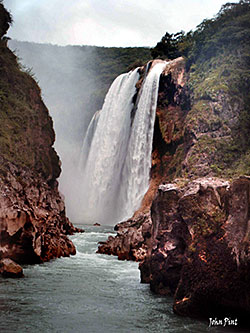
The
Tamul Cascade, 105 meters high, located in La Huasteca of San Luis
Potosí, now a candidate for becoming a Unesco Geopark.
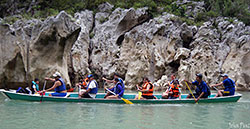
Members of Guadalajara’s Colli
outdoor adventure club row their
panga up the Tampaon River between sculpted walls of white limestone,
deep inside La Huasteca of San Luis Potosí.
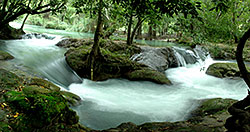
Micos,
on El Salto River in San Luis Potosí, has countless small waterfalls
and natural Jacuzzis.
Caves
beneath the dunes? Check out our Saudicaves page:

|
|
| Guadalajara's Primavera Forest proposed
as candidate |
|
|
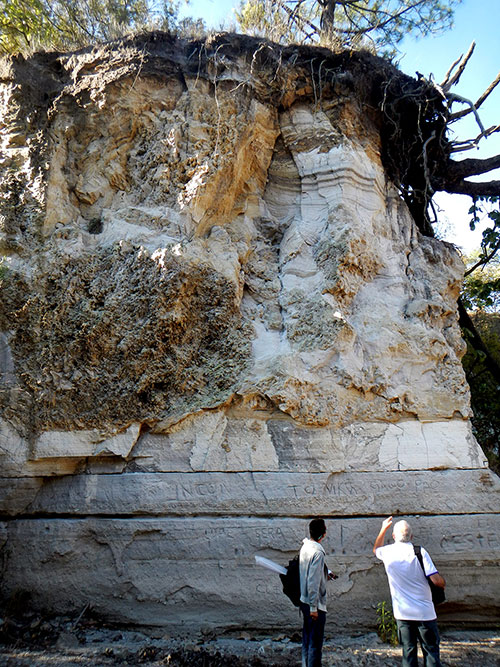 In
a press conference held on June 5, 2015, members of the University of
Guadalajara's Center for Social Sciences and Humanities (CUCSH)
proposed that Bosque la Primavera, an extensive flora and fauna reserve
lying directly west of the city, be transformed into a Geopark and a
candidate for membership in Unesco's highly esteemed Global Geoparks
Network (GGN). Pointing out that housing developments on the forest's
perimeter are continually encroaching on the Protected Area, UDG
investigators Luis Valdivia, Hildelgardo Gómez and Lucia González
stated that membership in the GGN would provide the “armor plating”
that the forest needs to survive in the future and that ejido and
private landowners within the forest boundary are enthusiastic about
the idea. In
a press conference held on June 5, 2015, members of the University of
Guadalajara's Center for Social Sciences and Humanities (CUCSH)
proposed that Bosque la Primavera, an extensive flora and fauna reserve
lying directly west of the city, be transformed into a Geopark and a
candidate for membership in Unesco's highly esteemed Global Geoparks
Network (GGN). Pointing out that housing developments on the forest's
perimeter are continually encroaching on the Protected Area, UDG
investigators Luis Valdivia, Hildelgardo Gómez and Lucia González
stated that membership in the GGN would provide the “armor plating”
that the forest needs to survive in the future and that ejido and
private landowners within the forest boundary are enthusiastic about
the idea.
Geoparks are typically nature reserves with
outstanding geological features which ordinary people can easily learn
to appreciate. At the moment, Unesco has registered 111 such parks
around the world, mostly in Europe and Asia and they focus on phenomena
like granite towers, lava domes, glacier landforms, dinosaur trackways,
sandstone pillars and places where the earth's mantle has been pushed
right up to the surface.
At the moment, there are
only four Geoparks in the Americas, two in Canada, one in Brazil and
another in Uruguay—but that may soon change. On May 28 to 29 of 2015, a
workshop was held at the Institute of Geography in Mexico City,
entitled, “Geoparks and Heritage; promoting geoheritage in Latin
America.” A Unesco team of experts outlined Geopark requirements to
representatives of Nicaragua, Ecuador, Peru, Chile, Argentina and
Mexico, who, in turn, presented Geopark projects already underway in
their respective countries.
Present at the workshop was UNAM
researcher José Luis Palacio, a long-time promoter of Geoparks in
Mexico. “This was truly an event of singular relevance,” he commented.
“We were able to meet with the world's greatest experts in this field.
Then, after all the presentations and meetings, the Unesco team went
off to visit six of the proposed Geoparks, including two here in
Mexico: the mountainous region of La Mixteca near Oaxaca and the
extraordinary landforms of La Huasteca of San Luis Potosí.”
In
addition to these two sites, there is a third candidate for Geopark
status in Mexico: the mining district of Hidalgo. Says Palacio: “All
three of these potential Geoparks will be evaluated in 2016 by two
Unesco experts, who will determine whether they meet the strict
requirements of the Global Network.” The final decision of the
evaluators will be announced in September of 2016 at the 7th
International Conference on Global Geoparks, which will meet in Great
Britain.
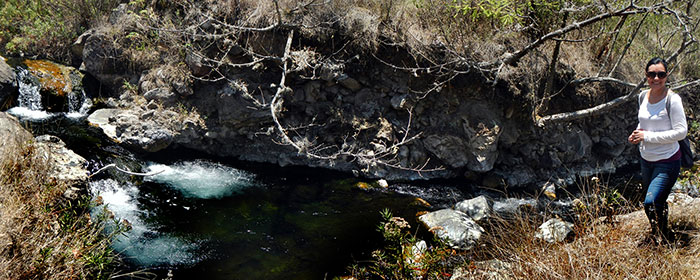
UDG researcher Lucía González
investigating the extremely hot Black River, which flows into Río
Caliente, one of the outstanding features of Bosque La Primavera.
The Primavera Forest's suitability for Geopark status
was proposed in a presentation at the 2011 Third Global Geotourism
Conference in Muscat, Oman by Guadalajara Reporter columnist John Pint.
Although this forest is not among the Mexican sites now under
consideration for GGN membership, it has, according to Pint, “all the
characteristics that Unesco looks for in candidates for Geopark status.
The Primavera Caldera is a Protected Area and the site of one of the
world's greatest explosions 95,000 years ago, which ejected 40 cubic
kilometers of volcanic rubble (jal) into the air, creating the area now
known as Jalisco. Fortunately, the story of this explosion and the lake
which occupied the area for up to 20,000 years, can be read in the
canyon walls of the Bosque, offering visitors to La Primavera a
dramatic lesson in geology as well as a chance to stroll through a
gorgeous forest and enjoy a delicious soak in the world-famous Río
Caliente.”
These and other characteristics of Bosque La
Primavera are now being documented by the CUCSH team proposing that the
forest be transformed into a Geopark. UDG geographer Luis Valdivia says
that the team is presently registering obsidian deposits and workshops,
archaeological ruins, fumaroles, hot and cold bathing pools and
bizarrely-shaped Tala Tuff rock formations. “The Bosque,” he says, “is
a natural for Geopark status.” |
|

